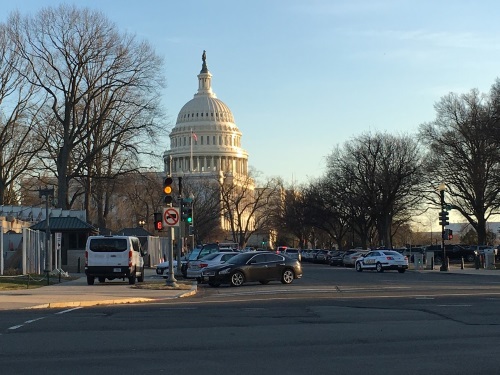Two key senators on the Subcommittee on Surface Transportation, Maritime, Freight, and Ports are urging the Federal Communications Commission to take “swift action” to enable deployment of Cellular Vehicle to Everything or C-V2X technology.
[Above photo by AASHTO]
Sen. Gary Peters (D-MI), the subcommittee’s chairman, and Sen. Cynthia Lummis (R-WY), want the FCC to accelerate the approval of C-V2X waivers so C-V2X systems can operate in the 5.9 gigahertz (GHz) wireless communication band.

“Swift action on these waivers is essential given C-V2X technology’s potential to reverse rising roadway fatalities,” the senators noted in a joint letter to the FCC.
“The National Highway Traffic Safety Administration has previously estimated that safety applications enabled by C-V2X could eliminate or mitigate the severity of more than 80 percent of light vehicle crashes,” they said. “C-V2X technology is poised to save lives, will pave the way for the future of automobile and transportation infrastructure, and is supported by public and private transportation stakeholders from local and state governments to industry, academia, and public safety groups.”

The American Association of State Highway and Transportation Officials has engaged in a multi-year effort to convince the FCC to preserve wireless spectrum for C-V2X and other vehicle-to-vehicle and vehicle-to-infrastructure communication systems and fully supports the letter co-signed by Sen. Peters and Sen. Lummis.
“AASHTO and its members have been at the forefront of the development and deployment of connected and automated vehicles, which have tremendous potential in significantly improving the safety of our surface transportation system as well as the mobility and accessibility for all system users,” noted Jim Tymon, AASHTO’s executive director.

“The FCC must take swift action for us to realize the critical life-safety and crash-prevention benefits enabled through deployment of C-V2X technologies,” he said.
In fact, AASHTO and the Intelligent Transportation Society of America filed a lawsuit in 2021 in the District of Columbia Circuit Court to prevent the FC from reallocating swaths of the 5.9 GHz wireless spectrum to non-transportation uses – a lawsuit ultimately dismissed by that court in August 2022.
That lawsuit sought to reverse the November 2020 decision by the FCC to shift 60 percent of the 5.9 GHz spectrum to unlicensed, non-transportation uses, while also preserving the full 75-megahertz (MHz) band within the overall 5.9 GHz spectrum for transportation communications. AASHTO and ITS America sought to preserve that spectrum for transportation systems such as C-V2X.

AASHTO’s Tymon had previously stressed to the FCC, Congress, and the White House that without the full 5.9 GHz spectrum available to use for connected vehicle technologies, it will be “significantly more difficult” to eliminate fatalities on America’s roadways each year, as well as safely deploy connected and automated vehicles.
“The 5.9 GHz band has been part of the spectrum that has been reserved for use for life-saving transportation technologies,” he emphasized. “At a time when we are trying to get to zero traffic fatalities, [we should] not give up the spectrum that the transportation community has been counting on – and has already made considerable investments in – to help save lives.”



